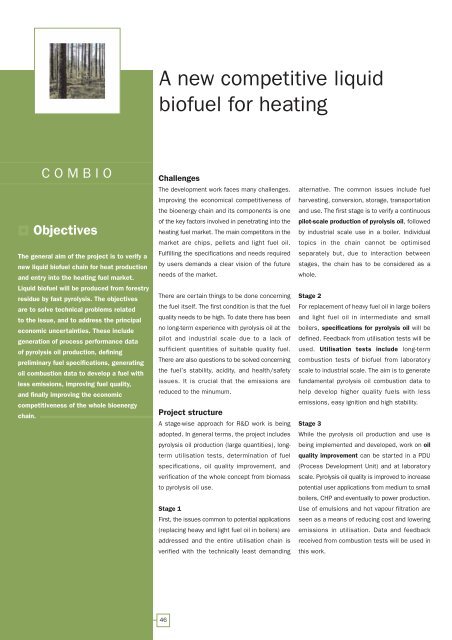European Bio-Energy Projects
European Bio-Energy Projects
European Bio-Energy Projects
Create successful ePaper yourself
Turn your PDF publications into a flip-book with our unique Google optimized e-Paper software.
COMBIO<br />
Objectives<br />
The general aim of the project is to verify a<br />
new liquid biofuel chain for heat production<br />
and entry into the heating fuel market.<br />
Liquid biofuel will be produced from forestry<br />
residue by fast pyrolysis. The objectives<br />
are to solve technical problems related<br />
to the issue, and to address the principal<br />
economic uncertainties. These include<br />
generation of process performance data<br />
of pyrolysis oil production, defining<br />
preliminary fuel specifications, generating<br />
oil combustion data to develop a fuel with<br />
less emissions, improving fuel quality,<br />
and finally improving the economic<br />
competitiveness of the whole bioenergy<br />
chain.<br />
A new competitive liquid<br />
biofuel for heating<br />
Challenges<br />
The development work faces many challenges.<br />
Improving the economical competitiveness of<br />
the bioenergy chain and its components is one<br />
of the key factors involved in penetrating into the<br />
heating fuel market. The main competitors in the<br />
market are chips, pellets and light fuel oil.<br />
Fulfilling the specifications and needs required<br />
by users demands a clear vision of the future<br />
needs of the market.<br />
There are certain things to be done concerning<br />
the fuel itself. The first condition is that the fuel<br />
quality needs to be high. To date there has been<br />
no long-term experience with pyrolysis oil at the<br />
pilot and industrial scale due to a lack of<br />
sufficient quantities of suitable quality fuel.<br />
There are also questions to be solved concerning<br />
the fuel’s stability, acidity, and health/safety<br />
issues. It is crucial that the emissions are<br />
reduced to the minumum.<br />
Project structure<br />
A stage-wise approach for R&D work is being<br />
adopted. In general terms, the project includes<br />
pyrolysis oil production (large quantities), longterm<br />
utilisation tests, determination of fuel<br />
specifications, oil quality improvement, and<br />
verification of the whole concept from biomass<br />
to pyrolysis oil use.<br />
Stage 1<br />
First, the issues common to potential applications<br />
(replacing heavy and light fuel oil in boilers) are<br />
addressed and the entire utilisation chain is<br />
verified with the technically least demanding<br />
46<br />
alternative. The common issues include fuel<br />
harvesting, conversion, storage, transportation<br />
and use. The first stage is to verify a continuous<br />
pilot-scale production of pyrolysis oil, followed<br />
by industrial scale use in a boiler. Individual<br />
topics in the chain cannot be optimised<br />
separately but, due to interaction between<br />
stages, the chain has to be considered as a<br />
whole.<br />
Stage 2<br />
For replacement of heavy fuel oil in large boilers<br />
and light fuel oil in intermediate and small<br />
boilers, specifications for pyrolysis oil will be<br />
defined. Feedback from utilisation tests will be<br />
used. Utilisation tests include long-term<br />
combustion tests of biofuel from laboratory<br />
scale to industrial scale. The aim is to generate<br />
fundamental pyrolysis oil combustion data to<br />
help develop higher quality fuels with less<br />
emissions, easy ignition and high stability.<br />
Stage 3<br />
While the pyrolysis oil production and use is<br />
being implemented and developed, work on oil<br />
quality improvement can be started in a PDU<br />
(Process Development Unit) and at laboratory<br />
scale. Pyrolysis oil quality is improved to increase<br />
potential user applications from medium to small<br />
boilers, CHP and eventually to power production.<br />
Use of emulsions and hot vapour filtration are<br />
seen as a means of reducing cost and lowering<br />
emissions in utilisation. Data and feedback<br />
received from combustion tests will be used in<br />
this work.

















